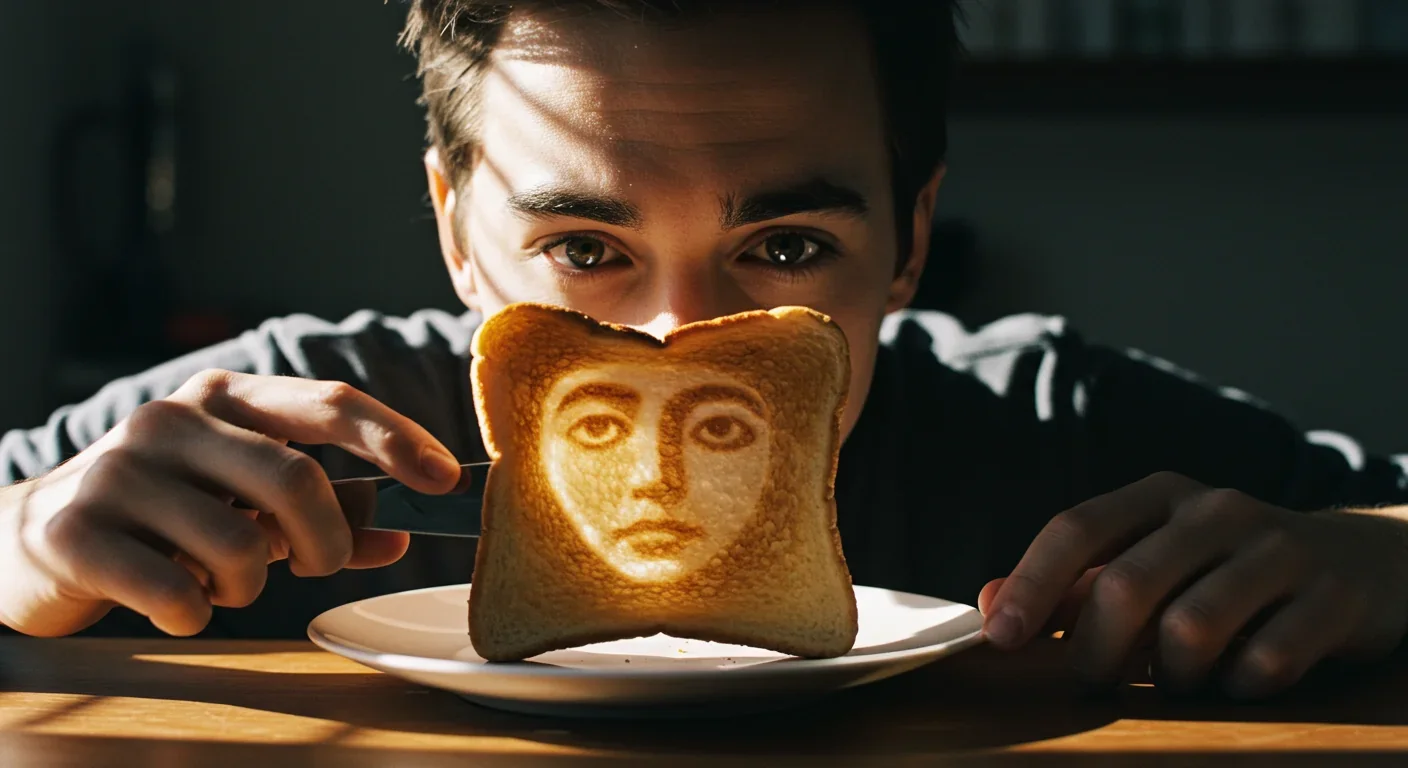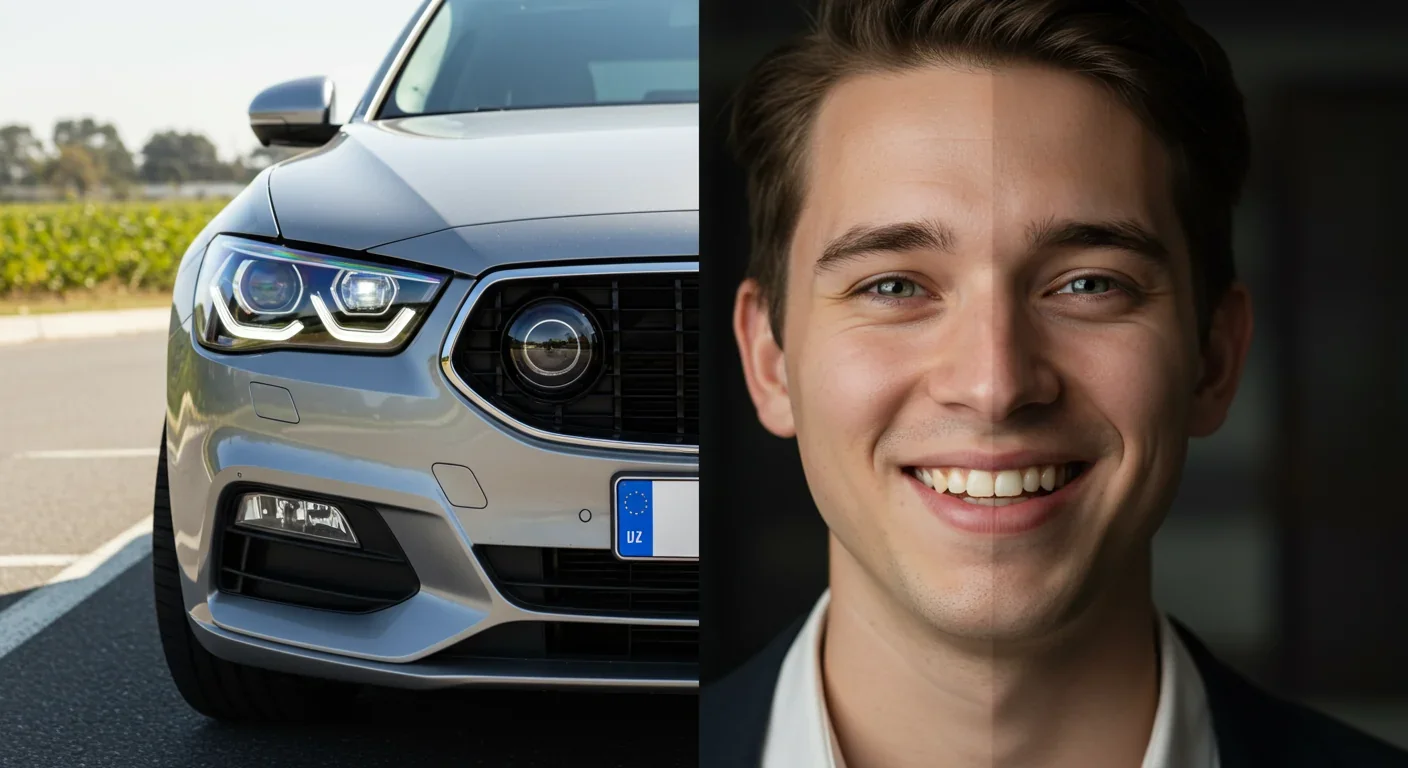Why Your Brain Is Hardwired to Lose Money

TL;DR: Your brain sees faces in toast and clouds because evolution favored false alarms over missed threats. This pattern recognition, called pareidolia, now shapes everything from marketing to mental health.

Your brain just played a trick on you. That outlet on the wall? It's smiling. The front of your car? Definitely has a personality. And that piece of toast you burned this morning? Yeah, it looked eerily like Abraham Lincoln, didn't it?
Welcome to pareidolia, the phenomenon that makes us see faces and patterns where none exist. It's not a glitch in your mental software. It's a feature that kept your ancestors alive long enough to pass their genes down to you. And in 2025, it's shaping everything from the AI systems we build to the ads that convince us to buy things.
Here's the survival math: Ten thousand years ago, if you saw a pattern in the bushes and assumed it was a tiger, you lived. If you ignored it because "it's probably just leaves," you became lunch.
This hair-trigger pattern detection became hardwired into our neural architecture through millennia of natural selection. The fusiform face area, a specialized region in your temporal lobe, fires up whenever it detects anything remotely face-like. It doesn't wait for confirmation. It doesn't double-check. It just screams "FACE!" and lets your conscious brain sort out the details later.
Research published in Frontiers in Human Neuroscience shows this happens in less than 170 milliseconds. That's faster than you can blink. Your brain commits to seeing a face before you even know you're looking at something.
The occipital cortex processes visual patterns, breaking down shapes, edges, and contrasts. Meanwhile, your temporal lobes handle complex stimuli like facial recognition. When these systems overlap, you get pareidolia: the compulsion to find meaning in randomness.
This wasn't designed for spotting Jesus in a grilled cheese sandwich. It evolved because false positives were cheap, but false negatives were deadly. Better to see a hundred imaginary threats than miss one real predator.
Understanding pareidolia means understanding how your brain constructs reality from incomplete information. Multiple neural networks collaborate in this process, each contributing a piece to the puzzle.
The fusiform gyrus, particularly the fusiform face area, acts as your brain's facial recognition specialist. Studies show it becomes so specialized that even Pokémon enthusiasts develop dedicated neural real estate for recognizing their favorite characters. Your brain literally rewires itself based on what matters to you.
The inferior temporal gyrus processes object recognition and helps categorize visual information. When you see two dots and a curved line, this region doesn't just identify geometric shapes. It searches its database for matching patterns and often lands on "face" because faces have been evolutionarily critical throughout human history.
Your amygdala adds emotional weight to these detections. When you see a "face" in your closet at 3 AM, it's your amygdala flooding your system with alarm signals. Research indicates trauma survivors show heightened amygdala activity, making them more prone to detecting patterns and potential threats.
The prefrontal cortex acts as quality control, evaluating whether that face you detected is real or imagined. But here's the catch: this rational override takes longer to kick in than the initial detection. You see the face first, then realize it's just a weirdly arranged coffee stain.
Not everyone experiences pareidolia with the same intensity. Neurodivergent populations often show enhanced pattern recognition abilities that can be both gift and burden.
Autistic individuals frequently demonstrate exceptional visual pattern recognition. The Enhanced Perceptual Functioning model suggests autistic brains allocate more resources to lower-level perceptual processes, increasing the ability to detect subtle patterns others miss entirely.

People with ADHD experience something called hyperfocus, where intense interest creates laser-like attention. During these episodes, they can discern patterns that neurotypical observers overlook. The trade-off? When they're not hyperfocused, their pattern detection can be scattered and inconsistent.
Trauma adds another dimension. Hypervigilance, a heightened state of sensory awareness, can amplify pattern recognition in social and environmental contexts. Your brain learns that missing patterns has consequences, so it becomes overzealous in finding them. Every shadow becomes worth investigating. Every ambiguous expression gets analyzed for hidden threats.
Some conditions diminish this ability entirely. Prosopagnosia, or face blindness, impairs the fusiform face area's ability to process facial features. People with this condition might struggle to recognize their own family members, let alone see faces in inanimate objects. It reveals just how specialized and crucial this neural machinery actually is.
Pareidolia shapes culture in surprising ways. In 1976, NASA's Viking 1 orbiter photographed what appeared to be a massive face on Mars in the Cydonia region. The image sparked decades of speculation about ancient Martian civilizations. Higher-resolution images later revealed it was just a mesa with unfortunate lighting. But the initial impact shows how powerfully pareidolia influences our interpretation of reality.
Religious imagery appears in natural phenomena with remarkable frequency. People report seeing Virgin Mary in tree bark, Jesus in tortillas, and divine signs in cloud formations. These experiences feel profound and meaningful to those who have them. The neuroscience doesn't diminish that meaning; it explains the mechanism that makes these experiences possible.
Marketers have weaponized this tendency brilliantly. Car manufacturers deliberately design front grilles to look like faces. Happy cars seem friendly and approachable. Aggressive cars look powerful and intimidating. We form emotional connections with these inanimate objects because our brains can't help but anthropomorphize anything with face-like features.
Product packaging uses similar tricks. Cleaning products smile at you from store shelves. App icons develop personalities through minimal geometric arrangements. Even buildings acquire character through the placement of windows and doors that accidentally create facial configurations.
Artists throughout history have exploited pareidolia intentionally. Giuseppe Arcimboldo painted portraits made entirely of fruits, vegetables, and flowers. Your brain oscillates between seeing the individual objects and perceiving the face they form. Contemporary artists continue this tradition, creating works that play with our compulsion to find patterns and meaning.
The same neural mechanisms that help us navigate social situations can lead us astray when they overreach. Apophenia, the broader tendency to perceive meaningful patterns in random data, represents pareidolia's more troublesome cousin.
Conspiracy theories thrive on apophenic thinking. People connect unrelated events into elaborate narratives because their pattern detection systems find correlations that don't actually exist. The patterns feel real. The connections seem obvious. But they're artifacts of an overzealous pattern recognition system searching for meaning in noise.
Gambling addiction exploits this tendency mercilessly. Slot machines present random outcomes, but our brains search for patterns anyway. We convince ourselves we've found the system, the secret sequence, the winning strategy. We haven't. We've just fallen victim to our own neural architecture.
Medical diagnostic errors sometimes stem from pareidolia. Radiologists might see tumors that don't exist or miss real ones because they're primed to find specific patterns. Training helps calibrate these tendencies, but the underlying challenge remains: our brains are prediction machines that sometimes predict incorrectly.
Social media algorithms amplify pareidolic thinking. We see patterns in how content performs, which posts get engagement, what the algorithm supposedly wants. Some patterns are real. Many are imaginary. But we treat them all as actionable intelligence because our brains crave coherent narratives.

Understanding pareidolia opens unexpected therapeutic possibilities. Cognitive behavioral therapy uses this knowledge to help people recognize when their pattern detection systems are giving false alarms.
Anxiety often stems from seeing threats that aren't there. Your brain detects a pattern, your amygdala sounds the alarm, and suddenly you're convinced something terrible is about to happen. Recognizing this as a feature of your neural wiring, rather than accurate threat assessment, creates space for rational evaluation.
Mindfulness practices help calibrate pattern recognition. When you notice you're seeing faces in clouds, you can observe that impulse without acting on it. You acknowledge the pattern your brain created while recognizing it doesn't represent external reality. This same skill transfers to emotional and social pattern recognition.
Art therapy leverages pareidolia therapeutically. Rorschach inkblot tests, for instance, reveal how individuals impose meaning on ambiguous stimuli. The patterns people see reflect their internal psychological landscape. Understanding these projections provides insight into thought processes and emotional states.
Creative expression benefits from embracing pareidolia. Photographers hunt for accidental faces in architecture. Painters incorporate hidden images into their work. Musicians find rhythmic patterns in random sounds. This playful engagement with pattern recognition exercises cognitive flexibility while reducing anxiety around ambiguity.
Scientists are just beginning to understand how pareidolia interfaces with artificial intelligence and machine learning. Computer vision systems trained on facial recognition sometimes exhibit their own versions of pareidolia, detecting faces in noise patterns because they've been optimized to find faces at all costs.
This reveals something profound about intelligence itself. Both biological and artificial systems that become skilled at pattern recognition develop tendencies toward false positives. The more aggressively you optimize for detecting real patterns, the more likely you are to hallucinate nonexistent ones.
Neuroscientists are using pareidolia to study how brains construct perceptual reality. Advanced imaging techniques show the precise timing of neural activation when subjects view ambiguous stimuli. Research published in Frontiers in Behavioral Neuroscience demonstrates that individual differences in pareidolia correlate with personality traits, suggesting this isn't just a quirky perceptual phenomenon but something fundamental to how we process information.
The intersection of pareidolia and technology raises fascinating questions. As augmented reality becomes ubiquitous, how will overlaying digital information onto physical reality interact with our built-in pattern recognition? Will we develop new forms of pareidolia adapted to mixed-reality environments?
Understanding pareidolia also informs how we design AI systems that interact with humans. If we know people unconsciously assign personality and intention to anything with face-like features, we can use that knowledge to create more intuitive interfaces or, conversely, to avoid accidentally anthropomorphizing systems that shouldn't carry emotional weight.
Pareidolia isn't something to eliminate or overcome. It's a fundamental aspect of how human consciousness constructs meaning from sensory input. The goal isn't to stop seeing faces in random patterns but to recognize when you're doing it and adjust your confidence accordingly.
Next time you see a face in your morning coffee foam or catch yourself convinced that your car looks sad, pause and appreciate the evolutionary masterpiece that is your brain. That false positive might feel silly, but it's the same neural machinery that lets you instantly recognize your friend in a crowd, interpret subtle facial expressions, and navigate the incredibly complex social world humans inhabit.
The key is calibration, not elimination. Your pattern recognition keeps you socially connected, creatively inspired, and occasionally entertained by random arrangements of objects. Just remember that not every pattern your brain detects corresponds to external reality.
In a world increasingly filled with AI-generated images, deepfakes, and manipulated media, understanding how your brain imposes patterns and meaning becomes a crucial literacy skill. You're not a passive receiver of sensory information. You're an active constructor of perceptual reality, and knowing that changes how you evaluate what you see.
So the next time someone shows you a piece of toast that looks like a celebrity, don't dismiss it as mere coincidence or foolish thinking. Recognize it as your magnificent, over-evolved, survival-optimized brain doing exactly what millions of years of evolution designed it to do: finding patterns, seeing faces, and making meaning from chaos. Just maybe don't sell it on eBay for ten thousand dollars.

MOND proposes gravity changes at low accelerations, explaining galaxy rotation without dark matter. While it predicts thousands of galaxies correctly, it struggles with clusters and cosmology, keeping the dark matter debate alive.

Ultrafine pollution particles smaller than 100 nanometers can bypass the blood-brain barrier through the olfactory nerve and bloodstream, depositing in brain tissue where they trigger neuroinflammation linked to dementia and neurological disorders, yet remain completely unregulated by current air quality standards.

CAES stores excess renewable energy by compressing air in underground caverns, then releases it through turbines during peak demand. New advanced adiabatic systems achieve 70%+ efficiency, making this decades-old technology suddenly competitive for long-duration grid storage.

Our brains are hardwired to see patterns in randomness, causing the gambler's fallacy—the mistaken belief that past random events influence future probabilities. This cognitive bias costs people millions in casinos, investments, and daily decisions.

Forests operate as synchronized living systems with molecular clocks that coordinate metabolism from individual cells to entire ecosystems, creating rhythmic patterns that affect global carbon cycles and climate feedback loops.

Generation Z is the first cohort to come of age amid a polycrisis - interconnected global failures spanning climate, economy, democracy, and health. This cascading reality is fundamentally reshaping how young people think, plan their lives, and organize for change.

Zero-trust security eliminates implicit network trust by requiring continuous verification of every access request. Organizations are rapidly adopting this architecture to address cloud computing, remote work, and sophisticated threats that rendered perimeter defenses obsolete.